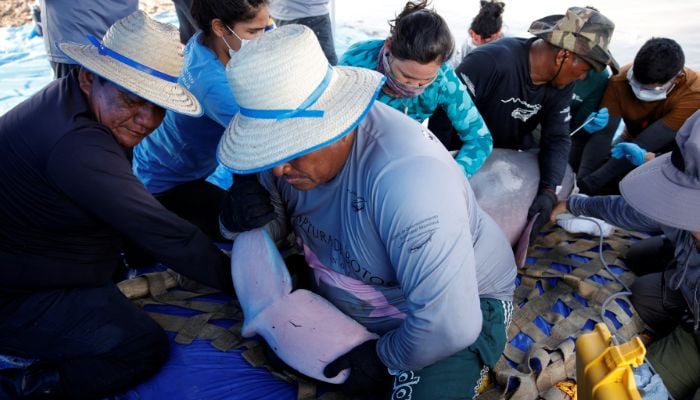Temporarily captured rare Amazon dolphins studied for climate change impact
Examination done to avoid repeat of 2023 when "200 Pink dolphins" were found floating on Lake Tefe
August 22, 2024

MANAUS: A team of biologists, vets and fishermen temporarily captured rare freshwater dolphins in the Amazon this week to study their health in hopes of avoiding a repeat of the deaths of hundreds of the mammals last year due to a severe drought.
The dolphins were brought ashore for blood tests and other examinations and returned to Lake Tefe in the Amazon basin as soon as the researchers had finished their work, which included inserting a microchip to monitor their behavior via satellite.
Fishermen were careful not to injure an adult female dolphin during capture and kept her close to her offspring to avoid stressing the animals.
"She relaxed and we could do all the tests. She appeared in good health," said project leader Miriam Marmontel of the Mamiraua Institute of Sustainable Development, which planned the expedition to temporarily capture up to 20 dolphins.
The work included removing a sample for a biopsy to see whether there were contaminants in her blubber, and the placing of the microchip on her back, which will allow researchers to follow her movements and the depths she swims at, and even determine water temperatures remotely.
In a grim fallout from the longest drought in the Amazon rainforest's recorded history last year, induced in part by climate change, the carcasses of more than 200 river dolphins were found floating on Lake Tefe, which is formed by a tributary of the Amazon River.
Low river levels during the drought heated the water to temperatures that were intolerable for the dolphins, researchers say. Thousands of fish also died in Amazon waterways due to a lack of oxygen in the water.
Pink dolphins
Marmontel said they hope to establish what caused last year's deaths before this season's drought set in as the Amazon dry season begins, so that researchers can react faster.
"We aim to learn more about the health of the dolphins at a time when water levels begin to go down and temperatures start to rise, so we can identify the changes and know whether they are due to higher temperatures or a toxin or pollutant in the water," she told Reuters.
The project was supported by the National Marine Mammal Foundation of California, whose researchers helped conduct ultrasound examinations on the dolphins.
Marmontel said most of the dolphins that perished last year were in Lake Tefe, a 45km-wide (27-mile) expanse of water where the dolphins like to be located, just off the Solimoes River.
"The lake's waters reached 40.9°C (105.62°F) during the 2023 drought, more than 10 degrees higher than the average for that time of the year. The water is now at 30°C (86°F)", said Ayan Fleischmann, a geosciences researcher at the Mamiraua Institute.









